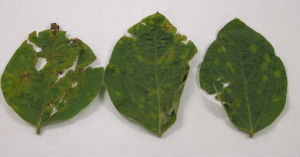Soybean fields damaged by heavy rain, winds and hail are showing symptoms of bacterial blight of soybean.
|
|
Leaves infected by Pseudomonas sp. are yellow or orange water-soaked angular lesions present. As lesions age, they turn dark brown and fall out of the leaf tissue, giving leaves a tattered appearance.
Bacteria survive on soybean residue and in seed, and enter plants through stomates and wound caused by equipment or other mechanical damage, or from weather events such as hard rains and hail. Long periods of leaf wetness and cool weather favor infection. Hot, dry weather will limit disease development.
Varieties will vary in their resistance, however resistance ratings may not be widely available. Yield loss may occur if disease is severe and plants defoliate. However, most fields in northwest Indiana exhibiting symptoms of bacterial blight are only moderately affected by the disease.
In-season control methods, such as copper fungicides, must be applied when symptoms first appear, and are generally not practical for managing the disease. Preventative management options include crop rotation, tillage, and planting resistant varieties. These methods can lower the risk of bacterial blight developing in the subsequent soybean crop.







Post a comment
Report Abusive Comment